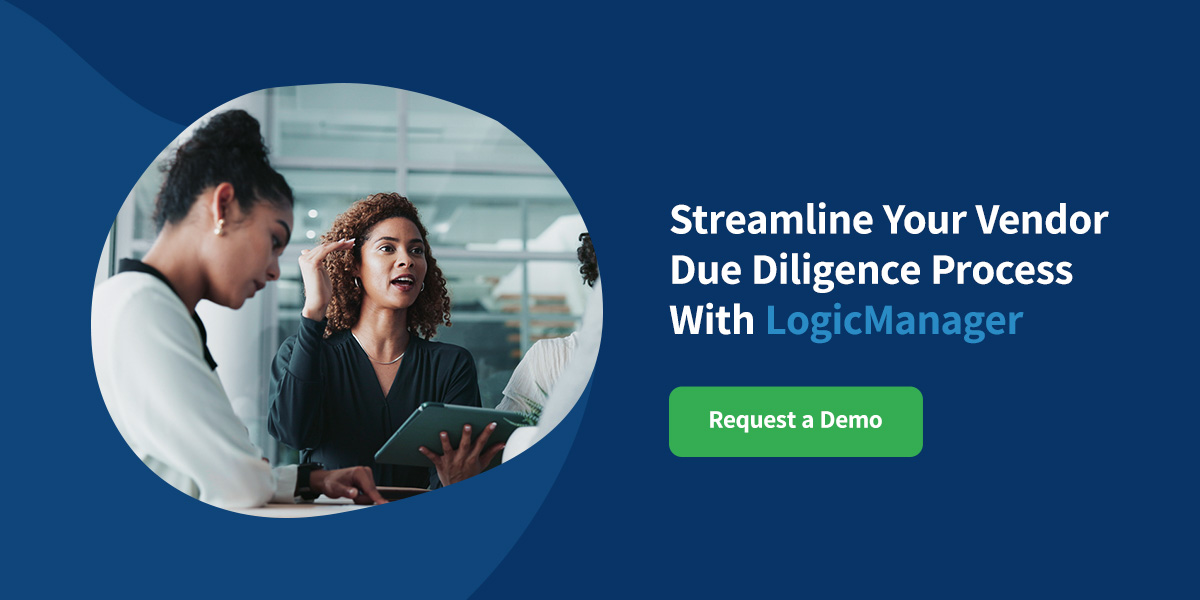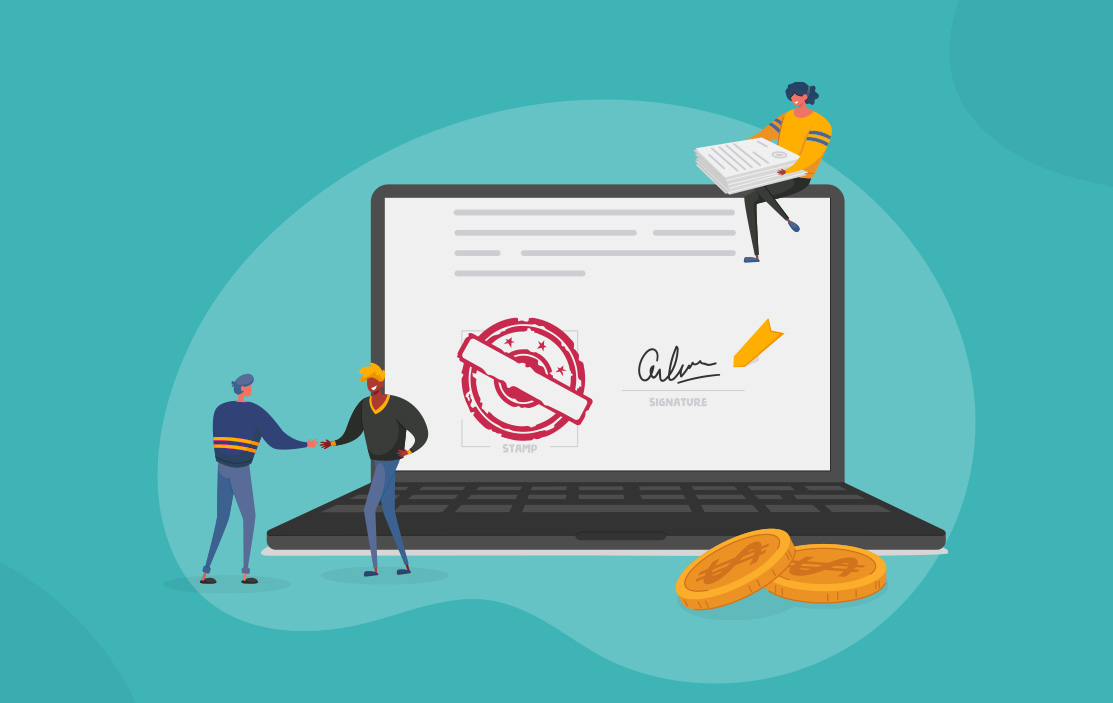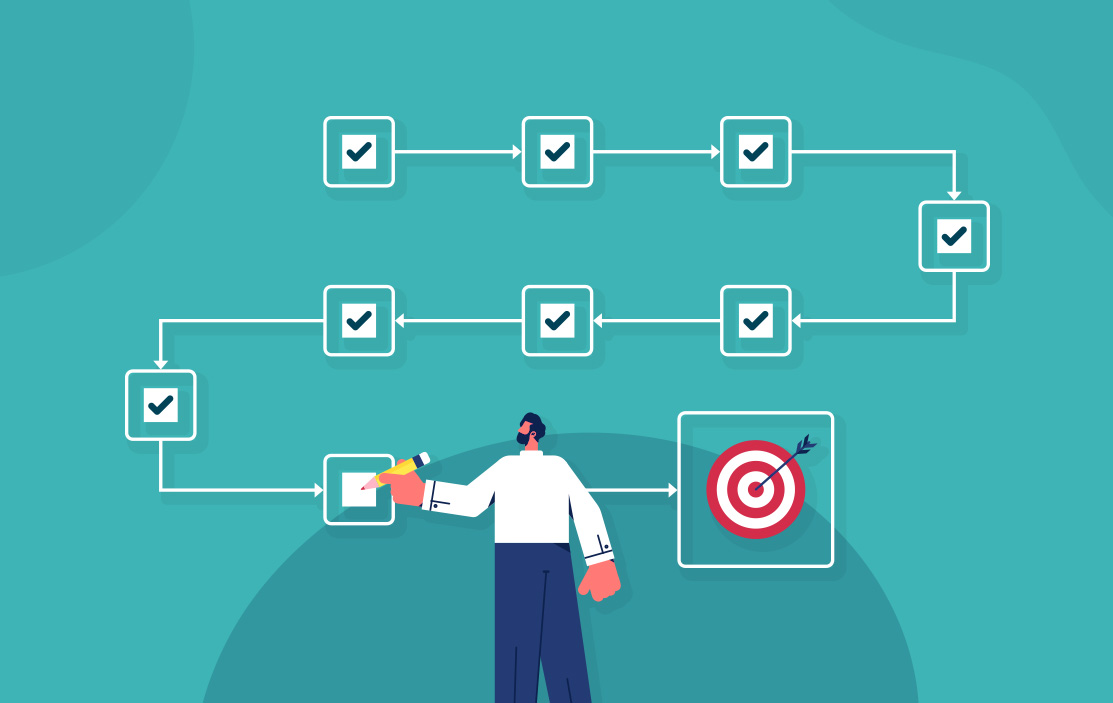Third-Party Due Diligence Best Practices
Last Updated: July 22, 2025
Managing third-party relationships is a crucial part of your operational risk strategy. Vendors often have access to business systems, data and customers, and due diligence can help protect your organization against compliance issues, service disruptions and reputational damage.
Third-party attacks have led to nearly 30% of breaches. This outcome highlights the need for robust risk management practices.
Explore what third-party due diligence is, why it matters and best practices to strengthen your process.
Table of Contents
- What Is Third-Party Due Diligence?
- Why Third-Party Due Diligence Is Important
- Third-Party Due Diligence Process
- Third-Party Due Diligence Best Practices
- Third-Party Due Diligence Checklist
- How to Create a Vendor Due Diligence Policy
- Using Vendor Due Diligence Software
- Features to Look for in Vendor Due Diligence Software
- Streamline Your Vendor Due Diligence Process With LogicManager
What Is Third-Party Due Diligence?
Third-party due diligence is the process of evaluating and verifying the integrity, reliability and risk exposure of the suppliers, vendors, contractors or service providers you work with. The process helps organizations assess:
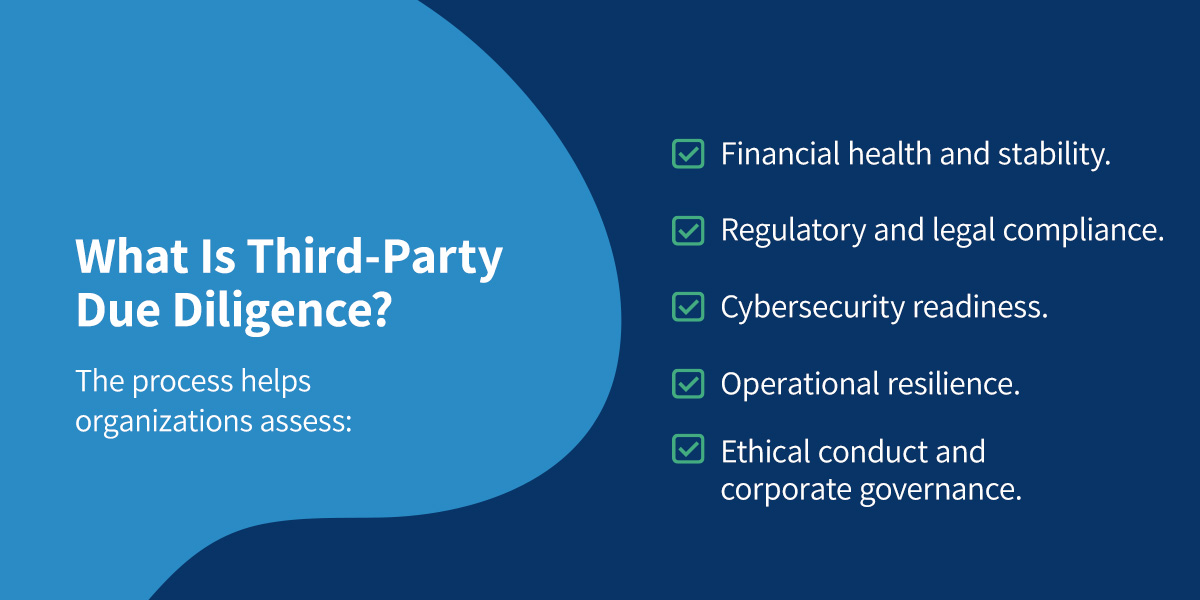
- Financial health and stability.
- Regulatory and legal compliance.
- Cybersecurity readiness.
- Operational resilience.
- Ethical conduct and corporate governance.
Why Third-Party Due Diligence Is Important
Some organizations are expected to show that they’ve taken reasonable steps to understand who they do business with. Explore why due diligence is crucial below.
1. Supports Compliance
Due diligence is a regulatory requirement for some industries. Without a formal process, companies may fall short during audits or regulatory reviews. Gaps in oversight may lead to contractual violations or legal liability.
Formalizing and documenting the due diligence process allows organizations to create an evidence-based trail that shows regulators and stakeholders that they’ve done their part.
2. Mitigates Risk
Vendors can undergo ownership changes, face cybersecurity breaches or implement operational practices that may introduce risk into an organization. Due diligence allows companies to anticipate these shifts before they result in disruption.
Risk-aware due diligence programs incorporate continuous monitoring and reevaluation. This approach ensures companies can identify emerging threats and address them promptly.
3. Ensures Business Continuity
Some businesses integrate vendors into customer experience systems. A breakdown at a single point in this chain can have ripple effects that disrupt operations and damage trust.
Due diligence enables companies to identify which vendors are critical to business continuity and apply scrutiny to those relationships. It also supports better contingency planning by surfacing single points of failure and suggesting backup plans where needed.
Third-Party Due Diligence Process
Establishing a repeatable and aligned process ensures companies uncover risks early and manage them throughout the vendor life cycle. Here are eight phases of due diligence.
1. Gather Information
The due diligence process begins with comprehensive data collection. The goal is to capture an accurate picture of the vendor’s identity, operations, structure and capabilities. A centralized platform can standardize this intake by using configurable forms or due diligence questionnaires for consistency.
Here are some vital details to compile:
- Basic company information, such as legal name, ownership and corporate structure
- Business license, certifications and accreditations
- Geographic locations and jurisdictions of operation
- Products or services offered
- Security protocols and data handling practices
2. Conduct Initial Risk Assessment
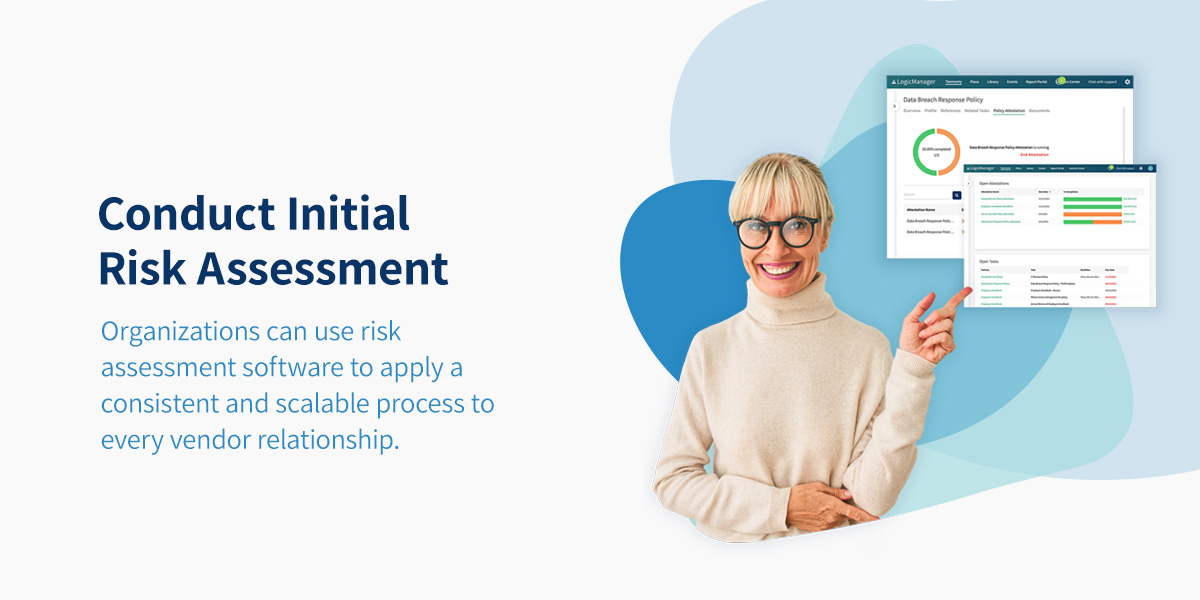
Assign an initial risk rating based on predefined criteria. Risk scoring frameworks help prioritize vendors for further review and determine the depth of due diligence required. Organizations can use risk assessment software to apply a consistent and scalable process to every vendor relationship.
Consider these factors:
- The nature of the data or services the vendor will access
- The vendor’s proximity to customer touchpoints or operational workflows
- Jurisdictional risk based on where the vendor operates
- Industry-specific regulatory assessments
3. Vet Third Parties
Conduct a background screening to validate the vendor’s integrity, legal standing and performance history. Organizations can manage the vetting process through due diligence platforms that integrate with risk intelligence tools to surface real-time insights.
The screening step should include the following:
- Sanctions and watchlist screenings
- Regulatory and litigation history
- Adverse media or reputational red flags
- Financial stability checks
- Review of third-party audit reports
4. Assess Your Risk
Vendor-specific risk should be evaluated in the context of your organization’s risk appetite and operating environment. Ultimately, risk is about how a vendor’s weakness could impact your business. Assess these factors:
- The potential impact of vendor failure on operations
- Dependency risk
- The likelihood of the risk materializing
- Existing internal controls that mitigate exposure
5. Conduct Enhanced Due Diligence
For higher-risk vendors or those flagged during earlier assessments, enhanced due diligence provides a deeper level of scrutiny. This may include the following:
- Site visits
- Operational audits
- Thorough financial analysis
- Physical record book checks
- Interviews with leadership or employees
- Hiring an external consultant or local investigator
6. Document Your Process and Decide
Every decision, risk rating, screening result and action taken should be recorded in a centralized system. A well-documented process creates a compliance audit trail and makes it easier for organizational teams to access the same vendor profile and collaborate. Using platforms that allow for centralized documentation and version control helps ensure that information stays current.
Use the findings to guide onboarding, negotiation or rejection decisions. This step may involve the following:
- Approving or rejecting the vendor
- Requesting mitigation measures
- Escalating issues to leadership
7. Monitor Continuously
Due diligence should be an ongoing process. Platforms with continuous monitoring capabilities help automate this process by identifying emerging risks and enabling faster responses.
Continuous monitoring may involve these factors:
- Quarterly or annual reassessments
- Automated alerts for changes in vendor status
- Examining cybersecurity ratings, regulatory developments or media coverage
8. Review Process
Regularly revisiting the due diligence process helps keep the program effective and aligned with internal risk tolerance and external regulatory expectations. Built-in review scheduling and dashboards support governance by highlighting what needs attention and when.
Here’s what reviews should cover:
- Changes to due diligence criteria or thresholds
- Performance feedback
- Efficacy of controls and mitigation plans
Third-Party Due Diligence Best Practices
A disciplined program combines sound governance, repeatable workflows and technology that scales. Follow the practices below for a balanced framework:
- Centralize third-party data: Maintain a single authoritative record for each vendor. A central repository improves version control, accelerates audits and allows cross-functional teams to see the same information simultaneously.
- Conduct thorough due diligence: Basic background checks may suffice for low-impact suppliers, while critical vendors might require on-site audits, cyber assessments or financial stress testing. A workflow and tasks engine ensures consistent depth without overburdening teams.
- Use questionnaires: An all-in-one questionnaire solution lets vendors answer once and reuse responses, reducing fatigue. Built-in scoring logic instantly highlights gaps, and conditional questions dig deeper where risk warrants.
- Verify self-reported information: Cross-check certifications, insurance levels, financial statements and security claims against independent data sources or public registries. Automated evidence-collection solutions can attach proof directly to the vendor profile.
- Prioritize third parties based on tiers: Tier vendors by business impact and risk. Tie review frequency, monitoring cadence and control rigor to that tiering. Organizations can use dashboards that map vendor risk across processes to help clarify where attention produces the greatest benefit.
- Assess employees and subcontractors: Request information on hiring practices, background checks and training programs. For critical services, confirm that the vendor’s own suppliers meet comparable standards.
- Automate processes: Use technology to issue questionnaires, send reminders, calculate risk scores and trigger approvals. Automation frees teams to investigate anomalies rather than chase paperwork.
- Continuously monitor vendors: Integrate threat-intel feeds, credit rating updates and cyber rating services so material changes surface in near real time. Alert rules route issues to the right owners before minor concerns escalate.
- Document everything: Capture decisions, risk ratings, evidence and corrective actions in an auditable trail. Robust documentation supports regulatory inquiries, reporting and post-incident analysis.
- Review and update regularly: Schedule periodic program reviews to reflect regulatory changes, lessons learned and evolving risk appetite. Version-controlled policies and templated assessments speed updates across hundreds of vendor relationships.
Third-Party Due Diligence Checklist
A comprehensive due diligence checklist ensures critical areas are covered, helping organizations stay compliant and promoting operational resilience. Organizations can streamline this process by using a downloadable third-party due diligence checklist.
The depth of a review may vary depending on the risk level, but consider the categories below.
1. Basic Company Information
Start with foundational data to confirm the third party’s identity and legitimacy. Compile this information:
- Legal business name and registration
- Tax ID or equivalent business identification number
- Corporate structure and ownership details
- Geographic locations and jurisdictions of operation
- Length of time in business
- Key executive contacts and decision-makers
2. Financial Health
A vendor’s financial stability can affect their ability to deliver on commitments. Here’s what to assess in this section:
- Audited financial statements or income summaries
- Credit ratings or financial risk scores
- Outstanding liabilities or debts
- Payment histories and default records
3. Reputational Risk
Public perception and historical conduct can signal how a vendor may perform under pressure or scrutiny. Look at the following:
- Legal and regulatory history
- Media monitoring for adverse news mentions
- Industry reputation and peer reviews
- Conflict of interest declarations
- Ethics and corporate responsibility policies
4. Cybersecurity and Data Protection
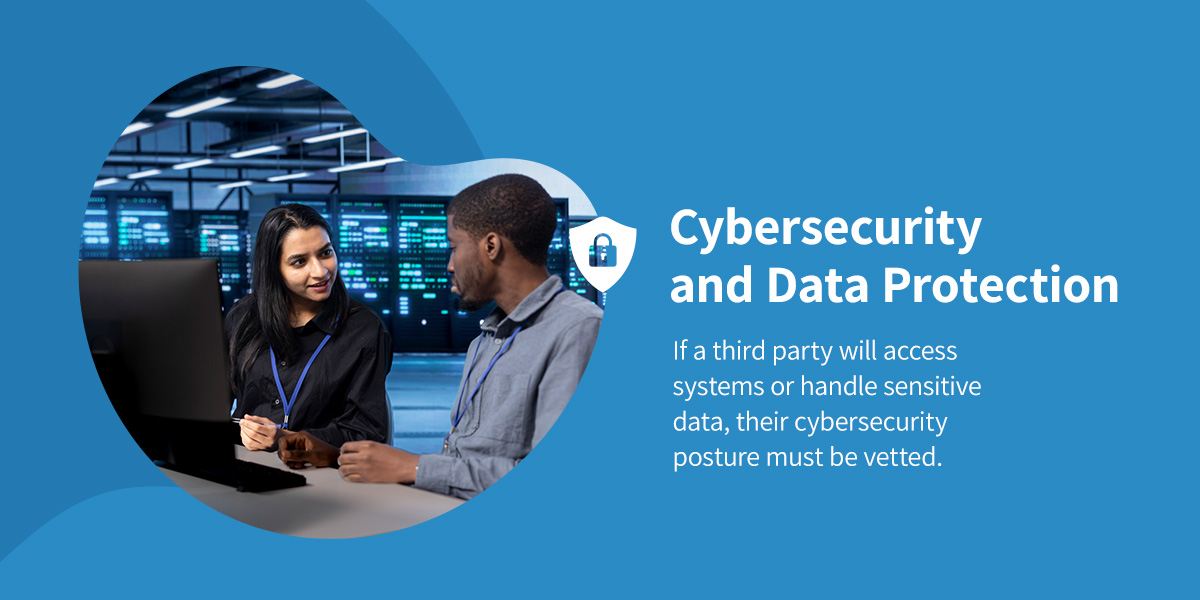
If a third party will access systems or handle sensitive data, their cybersecurity posture must be vetted. Evaluate these factors:
- Security certifications
- Incident history and breach disclosures
- Data encryption and access control practices
- Security training and awareness programs
5. Compliance and Legal
Assess the vendor’s ability to comply with industry and jurisdictional requirements. Add these items to your checklist:
- Regulatory licensing or registrations
- Anti-bribery and anti-corruption policies
- Export and import controls and trade sanctions screenings
- Conflict minerals or human rights disclosures
6. Operational Risk
Operational reliability ensures the vendor can meet delivery timelines, performance expectations and service levels. Examine the following:
- Quality assurance programs
- Process documentations and standard operating procedures
- Supply chain dependencies
- Production capacity and scalability
- Incident management protocols
- Business continuity plans
7. Contractual Terms
Before finalizing engagements, review these items:
- Service level agreements
- Termination clauses and exit plans
- Liability and indemnity provisions
- Insurance coverage
- Intellectual property ownership and usage rights
- Subcontractor approvals and oversight clauses
8. People and Processes
Who does the work and how can be just as important as what the work is. Assess these processes and practices:
- Hiring practices and background checks
- Employee training
- Turnover rates and succession planning
- Employee certifications or credentials
- Labor practices and workplace safety standards
How to Create a Vendor Due Diligence Policy
A vendor due diligence or enterprise management policy helps your organization assess and manage third-party risk. It sets expectations, defines roles and outlines a repeatable framework that ensures consistency across departments. Here are some components a policy should include:
- Scope: Clearly define which types of vendors fall under the policy. This could be assigned by risk, service category, access to sensitive information or contractual size. This helps allocate effort proportionally and avoids overburdening low-risk relationships.
- Roles and responsibilities: Assign ownership across teams. For example, procurement may own data collection, legal may handle contract terms and risk, and compliance may manage final review and scoring. Clear accountability ensures each phase of due diligence is executed and reported properly.
- Review cycles: Set a cadence to review the policy, evaluate the effectiveness of current processes and update practices based on emerging risks or regulatory shifts.
Using Vendor Due Diligence Software
Spreadsheets, email chains and scattered documentation may lead to incomplete assessments and delayed reviews. Vendor due diligence software offers a scalable, centralized solution that streamlines workflows, enhances visibility and brings structure to a collaborative process.
This approach has several advantages:
- Fewer gaps: Built-in logic ensures you don’t skip required steps. The right follow-up activities can be automatically triggered based on defined rules.
- Audit readiness: Centralizing all documentation creates a repeatable record for internal or regulatory audits.
- Improved visibility: Dashboards offer real-time insights into where vendors stand in the process, what risks have been identified and what actions are pending, helping leadership make timely, data-driven decisions.
- Increased efficiency: Automated workflows cut down on repetitive tasks.
Features to Look for in Vendor Due Diligence Software
Selecting the right platform depends on your organization’s risk appetite, industry needs and internal resources. However, common features to consider include:
- Risk-based workflows: Tailor assessment depth based on a vendor’s criticality or data access level.
- Central document repository: Store and track policies, contracts, certifications and assessment results securely and accessibly.
- Configurable questionnaires: Dynamic forms adapt to vendor responses, reducing fatigue while collecting only the most relevant data.
- Third-party data integrations: Integrate with tools like RiskRecon or BitSight to access cybersecurity ratings, financial stability scores or reputational intelligence.
- Real-time dashboards and reporting: Generate dynamic reporting to monitor trends, identify issues and surface insights.
- Automated reminders and task assignments: Built-in alerts keep teams on track and ensure accountability.
Streamline Your Vendor Due Diligence Process With LogicManager
LogicManager helps organizations take a risk-based approach to vendor due diligence. Our Enterprise Third Party Risk Management Software enables centralized, non-siloed programs that align teams, standardize processes and reduce manual work.
With configurable risk libraries and due diligence templates, you can tailor workflows to your needs. Our platform integrates with tools like Workday, DocuSign, Office 365, BitSight and RiskRecon. You also get access to automated dashboards, customizable third-party due diligence reports and Risk Ripple Analytics.
Advisory analysts, technical guidance and onboarding help are included in your pricing, with no hidden fees.
Request a demo today to get started.

